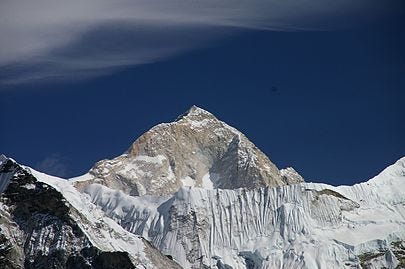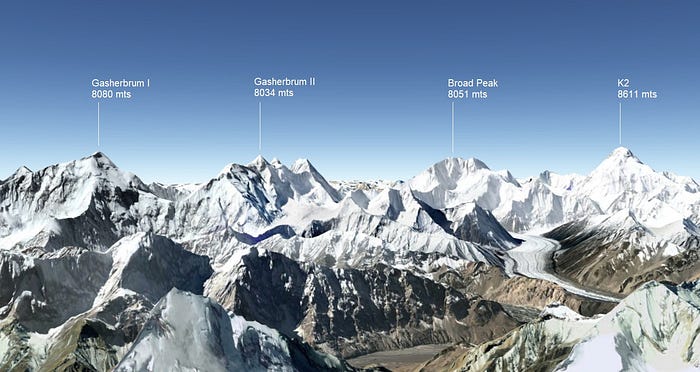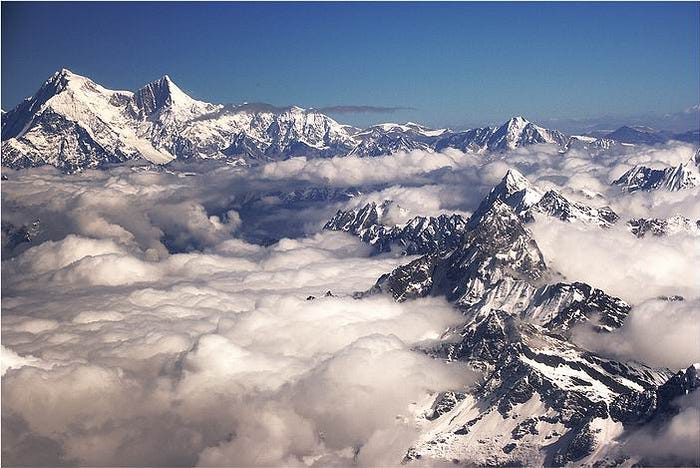The Eight Thousanders
As a first in my geography series of blogs, I’ll be writing about the fourteen highest mountains of planet Earth, all located in (and around) the Himalayas, and popularly known as the eight-thousanders. The Himalayas, as we all know, is the home to the highest mountains on Earth. The mountain range has a very well-suited name — literally meaning Abode of Snow (Him — Snow, alaya — dwelling or place).
This is going to be a long one, but I promise you it will be worthwhile!
The eight-thousanders are fourteen mountains which have an elevation for more than 8,000 meters above sea level. Naturally, they’re also the fourteen highest mountains on the planet. The list is obviously topped by Mount Everest, probably the most popular mountain — so popular that people outside the mountaineering community hardly know about the thirteen rest.
The thirteen unpopular mountains of the list should be the 13 Reasons Why geography should be taught with great detail in Indian schools.
However, before I begin talking about the eight-thousanders, I’d like to shed some light on how the Himalayas were formed. That will put things into perspective.
A mountain range is born
More than 140 million years ago, when the supercontinent called Gondwana was splitting apart, the landmass what is now India started drifting northeast towards what is present day Asia. Covering a distance of about 6000 km in about 40 to 50 million years, the Indian plate collided with the Eurasian plate, causing a lot of crumbing of gigantic chunks of the crust throughout the northern edge. This crumbling, and resulting mountainous terrain took 10 million more years to become what is Himalayas today.
Exploring the unexplored
As humans, we have been fundamentally coded to follow our curiosity to the extremes. And hence, we started exploring the unexplored to figure out the highest mountains on the Earth.
Did you know that until the 1850s, we were unaware that Mount Everest even existed?
After years of difficult trigonometric calculations, we figured out the highest mountains by the 1900s. Thanks to advances in technology, such as the introduction of satellites, we are now able to very accurately calculate the heights of all peaks.
The greatest challenge
The fourteen eight-thousanders are all above 8,000 meters in elevation. An altitude this high poses a serious challenge for humans — lack of air. As we go higher, the atmosphere of the Earth starts thinning and the height of 8,000 meters above sea level is nearly at the upper limit of the troposphere (which is the lowest layer of the atmosphere holding breathable air).
At this height, the air pressure is so low that humans are only able to consume 30% of the oxygen that they would take in at sea level. Such a low level of oxygen causes people to lose consciousness, and death awaits if not treated right away. This fact, along with insanely low temperatures, has given the 8,000+ meters region the nickname Death Zone.
The effect of the Death Zone is so profound that people get affected directly (loss of basic human body processes) or indirectly (wrong decisions taken under stress and weakness). This is a major reason why the eight-thousanders are considered the most challenging and are most respected by mountaineers worldwide.
The Eight-Thousanders List
Let’s jump straightaway to the fourteen eight-thousanders of planet Earth.
1. Mount Everest (Sagarmatha; Chomolungma)

At an elevation of 8,848 meters, Mount Everest is Earth’s highest mountain above sea level. Originally mapped as Peak XV, Everest was discovered to be the highest mountain in the 1850s after surveys estimated its height to be 8,840 meters. Situated at the border of China and Nepal, it is called Chomolungma (Holy Mother) and Sagarmatha (Goddess of the Skies) in Tibetan and Nepalese languages respectively.
Although the highest in the list, the mountain is considered relatively easier to climb than a few other eight-thousanders. Given its simpler climb and the status of being the highest, it has been climbed by more than 5600 people so far. Nevertheless, 2 in every 50 climbers (4%) die on the mountain.
The mountain was first attempted to be climbed by the British in the 1920s. Mountaineers George Mallory and Andrew Irvine attempted to conquer the peak in 1924. They were last reported at a height of 8,400 meters but never returned. It still remains a mystery whether they ever made it to the summit. The first successful summit was made by Edmund Hillary and Tenzing Norgay in May 1953.
2. K2 (Godwin-Austen / Chhogori)

Located in the Karakoram range (which is not always considered to be part of the Himalayas), K2 is the second highest mountain on Earth at 8,611 meters above sea level.
The mountain is located near the disputed border regions of India, Pakistan and China. At an international level, Pakistan claims this mountain to be its highest. It is located about 60 kilometres northwest from Siachen Glacier.
The name K2 (short for Karakoram 2) was a codename given by early surveyors. The mountain’s location is so remote that it had no given name by the locals of the region when it was discovered. Hence, the name K2 has been passed on as the official name. The mountain was also unpopularly named Godwin-Austen in honour of an early explorer in the region.
The region around K2 is so heavily glaciated that it is sometimes called the third pole of the Earth. K2 is part of a group of very high mountains, three of which (excluding K2) are also eight-thousanders. The mountain has the second highest fatality rate in this list — 1 in every 4 climbers (25%) die on the mountain. This scary number, along with the extreme weather in the region, has earned it the nickname Savage Mountain. K2 was first ascended by Italian mountaineers Achille Compagnoni and Lino Lacedelli in 1954. The first winter climb was achieved by Nepal-born mountaineer Nirmal Purja in January 2021.
3. Kangchenjunga

Kangchenjunga (the five treasures of the high snow) is the third highest mountain on Earth at an elevation of 8,586 meters above sea level. Located at the border of Nepal and India, it is also the highest mountain of the latter in an undisputed location. By traditional definitions, Kangchenjunga is considered to be the western anchor of the Himalayan mountain range.
Kangchenjunga was considered to be the highest mountain on earth until 1852 before Mount Everest was found to be higher in 1856. The mountain was first climbed in 1955 by English mountaineers Joe Brown and George Band. The mountain is considerably more fatal than Mount Everest — 3 in every 20 climbers die (15%) on the mountain.
The mountain can be seen from as far as Darjeeling in India.
4. Lhotse

Lhotse (south peak) is the fourth highest mountain on Earth at 8516 meters above sea level. Part of the Everest massif, Lhotse is connected to the parent mountain by the sharp-edged pass called the South Col. The international border between China and Nepal passes through the summit of Lhotse.
Lhotse was first ascended in 1956 by Swiss climbers Fritz Luchsinger and Ernst Reiss. The mountain is relatively easier to climb than its parent — 3 in every 100 climbers (2.8%) die summiting the mountain
Even though the mountain is just about 2.6 kilometres away from Everest, and appears to be part of the latter, it is considered to be a separate peak since it has a prominence of 610 meters, more than the generally accepted values of 300–500 meters. The figure below explains this situation better.

5. Makalu

Makalu is the fifth highest mountain on Earth at 8,485 meters above sea level. An isolated peak, Makalu is located about 19 kilometres southeast of Mount Everest on the border of Nepal and China. It was first ascended in 1955 by French mountaineers Lionel Terray and Jean Couzy. About 9 in every 100 climbers (9%) die reaching the summit of Makalu.
6. Cho Oyu

The sixth highest mountain on the Earth, Cho Oyu rises 8,188 meters above sea level. Located 20 kilometres west of Mount Everest on the border of Nepal and China, the mountain is close to Nangpa La, an important pass and the main trading route between Tibetans and Sherpas in the region. Originally ranked seventh in the list, it’s elevation was revised later causing it to move one place up in the list.
First ascended by an Austrian expedition in 1954, Cho Oyu has the lowest fatality rate among the eight-thousanders — about 1 in 100 climbers die (1.4%) reaching the summit. It is the second most climbed eight-thousander after Everest with more than 3,100 climbs so far.
7. Dhaulagiri

At 8,167 meters above sea level, Dhaulagiri is the seventh highest mountain on Earth. Located entirely within Nepal, it is the highest mountain located within the borders of a single country. The name is Sanskrit in origin, meaning the Dazzling Mountain.
Another eight-thousander, Annapurna, is located about 30 kilometres east of Dhaulagiri. The mountains are separated by the Kali-Gandaki river gorge.
Dhaulagiri was first climbed in 1960 by a Swiss/Austrian/Nepali expedition. about 3 in every 20 climbers (15%) die while ascending the mountain.
If one measures the difference of height between the base of the river and the height of the mountains, the Kali-Gandaki gorge is the world’s deepest with a height difference of over 7,000 meters.
8. Manaslu

Manaslu is the eighth highest mountain on Earth at 8,163 meters above sea level, just 4 meters shy of Dhaulagiri. The mountain is located entirely within Nepal and was first climbed in 1956 by a Japanese expedition.
The mountain is known for its long ridges and valleys in all direction, which steeply rise to form a pyramidal shape.
1 in every 10 climbers dies (10%) reaching the summit of Manaslu.
9. Nanga Parbat (Diamer)

At 8,126 meters above sea level, Nanga Parbat is the ninth highest mountain on Earth. The mountain is located in the Gilgit-Baltistan territory in the Kashmir region disputed between Pakistan and India. Nanga Parbat acts as the western anchor of the Himalayas.
The mountain has a tremendous rise in elevation compared to the nearby plains. The elevation rises by more than 7,000 meters in just 25 kilometres. The Indus river passes north of the mountain.
The name is derived from Sanskrit, meaning the Naked Mountain, referring to the openness of the mountain when seen from surrounding areas. The local name Diamer is of Tibetan origin, meaning “Huge Mountain”.
Nanga Parbat has the third highest fatality rate among the eight-thousanders. 1 in every 5 climbers (20%) dies trying to reach its summit. It is hence also called the Killer Mountain. The first ascent was made by Hermann Buhl in 1953.
10. Annapurna

Annapurna, located entirely within Nepal and 30 kilometres east of Dhaulagiri (seventh in this list), is the tenth highest mountain on Earth. Annapurna is located about 40 kilometres northwest of Pokhara, Nepal and about 20 kilometres south of Muktinath, the sacred Hindu place. The name is commonly translated as Goddess of the Harvests.
Annapurna was the first eight-thousander to be climbed, a feat that was achieved in 1950 by a French expedition. It was also the highest summited mountain until Everest was climbed by Hillary and Norgay in 1953. The mountain is separated from its neighbour Dhaulagiri by the Kali-Gandaki river gorge, which is considered to be the deepest in the world.
The mountain has the highest fatality rate among the eight-thousanders. 1 in every 3 climbers dies on Annapurna, a staggering 34% fatality rate. This high fatality rate prevents mountaineers from climbing this mountain — only 191 summit attempts have been tried to date.
Its ironic how “Goddess of Food and Harvest”, a term which we usually associate with life and well being, can be the deadliest mountain in the world!
11. Gasherbrum I (Hidden Peak)

At 8,080 meters, Gasherbrum I is the eleventh highest mountain on Earth. Located in the Karakoram range, its only about 25 kilometres south of K2, the second highest mountain on Earth. Part of the Karakoram eight-thousanders group, the peak is the first in the line for four continuous eight-thousanders when counted from south to north. The name Gasherbrum means Beautiful Mountain in the local Balti language.
Gasherbrum I was first climbed in 1958 by an American expedition. The fatality rate is near 9%.
12. Broad Peak

Broad Peak is the twelfth highest mountain on Earth at 8,051 meters above sea level. Located in the remote Karakoram range, Broad Peak is just 8 kilometres south of K2. Its summit area is more than 1.5 kilometres in length, hence the given name.
First climbed in 1957 by an Austrian expedition, Broad Peak has been climbed 400 times so far. 5% of the people climbing die on the mountain.
13. Gasherbrum II

At 8,035 meters above sea level, Gasherbrum II is the thirteenth highest mountain on Earth and the lowest of the eight-thousanders in the Karakoram region. The mountain is located between Gasherbrum I and Broad Peak, and was first summited in 1956 by an Austrian expedition. The fatality rate is second-lowest among the eight-thousanders. 1 in 50 climbers dies (2%) trying to ascend the mountain.
The Karakoram eight-thousanders make a continuous chain of 8,000 meters high peaks within a span of 25 kilometres. Have a look below, it is a beautiful sight indeed!

14. Shishapangma (Gosainthān)

At an elevation of 8,027 meters above sea level, Shishapangma is the last in the list. Located entirely within China, it is also the highest mountain located entirely within the country. The name Shishapangma translates to “crest above the grassy plains”, due to its location in the Tibetan plateau, while the Sanskrit name Gosainthan means “place of the saint”.
Shishapangma was the last eight-thousander to be climbed due to travel restrictions imposed by the Chinese government. The mountain was first climbed in 1964 by a Chinese expedition.
The mountain has an 8% fatality rate — 4 in 25 climbers die ascending the mountain.
In popular culture, Shishapangma was depicted in Herge’s comic Tintin in Tibet, in which a plane carrying the protagonist’s friend crashes near the mountain. His friend is the only survivor and is saved by Yeti, the mythical snowman in Tibetan culture.
And those are the eight-thousanders! This was an attempt by me to shed light on the unknown highest peaks of our planet. I’ll be writing more on geography in the coming days, so stay tuned. Also, don’t hesitate in asking me questions or suggesting me topics to write on!
If you find this blog to be interesting and informative, do appreciate my efforts by sharing this blog with your friends and family.
Until next time!
